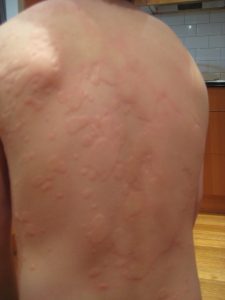Also known as…Hives
What is Urticaria?
Urticaria, or hives (sometimes referred to as welts or wheals), is a common skin condition that produces an itchy rash. It tends to come and go and can last for a variable period of time. It is sometimes accompanied by angioedema, which is swelling deeper in the skin, typically affecting the lips and peri-orbital areas of the face, but which may also involve the upper airways. The condition can be acute (lasting less than 6 weeks) or chronic (lasting longer than 6 weeks). It may be caused by a trigger, but most cases of urticaria have no known cause.
Urticaria occurs due to the release of chemical mediators including histamine from mast cells in the skin. These mediators activate sensory nerves and cause small blood vessels to leak. This process is usually triggered by various immune pathways such as circulating IgE antibodies.
The cause of this immune triggering is unknown in the majority of cases, but are commonly associated with various types of infections. Other triggers include chronic immunologic diseases, stinging and biting insects, allergy to foods or medications. The use of intravenous dyes during some radiological tests can sometimes trigger urticaria as well.
Physical urticaria is urticaria which develops with skin exposure to heat, cold, pressure, exercise, water, vibration or sunlight. These conditions probably result from heightened skin sensitivity, although the exact mechanism is unknown.
Urticaria typically is a smooth, raised rash. The colour can range from normal skin colour to pink or red. The rash may occur anywhere on the body and often starts off as small round spots that quickly enlarge and spread. The rash can be intensely itchy, but usually only lasts minutes to hours and then disappears within 24 hours.


A viral or bacterial illness can occur before urticaria develops.
Some chronic medical conditions such as systemic lupus erythematosus, mastocytosis or rheumatoid arthritis may occur with chronic urticaria. If the rash becomes painful, starts to show bruise like staining of the skin or lasts longer than 36 – 48 hours, then another condition called urticarial vasculitis should be suspected.
No specific tests are required for acute urticaria, as the condition is often expected to resolve spontaneously, and tests to try to find a specific cause are usually not helpful. Allergy testing may be required if a specific food or contact trigger is suspected.
For chronic urticaria, tests involving blood, urine and stool specimens may be required to identify any infection or underlying chronic immune disorder that may be causing the condition.
The specific triggers that have been identified (such as a food or medication) should be avoided. In most cases, acute urticaria is self-limited and resolves spontaneously within 6 weeks. During this period, treatment with oral antihistamines is indicated for relief of itch and swelling. Antihistamines are commonly available as over-the-counter medications. These are often needed at higher doses than described on the package. They are very safe and helpful, but need to be taken regularly. In cases where antihistamines fail to control symptoms, stronger medications may be needed.
Chronic urticaria is also frequently treated with antihistamine medication. They can often be effective in stopping itch, helping the rash to resolve and preventing future outbreaks of urticaria. If antihistamines are inadequate, other treatments are available. These include other histamine blockers, leukotriene inhibitors, phototherapy, hydroxychloroquine and immune suppressing medications.
For chronic spontaneous urticaria, an injectable prescription medication called Omalizumab may be indicated for use in patients unresponsive to antihistamines. Medication usually needs to be continued for many weeks and long term treatment may be required in some cases to keep the condition under control.
Further information about urticaria www.allergy.org.au
This information has been written by Dr Gayle Ross, Dr Brent Doolan and Dr Nicholas Aspres.
Disclaimer
2019 © Australasian College of Dermatologists.
You may use for personal use only. Please refer to our disclaimer.